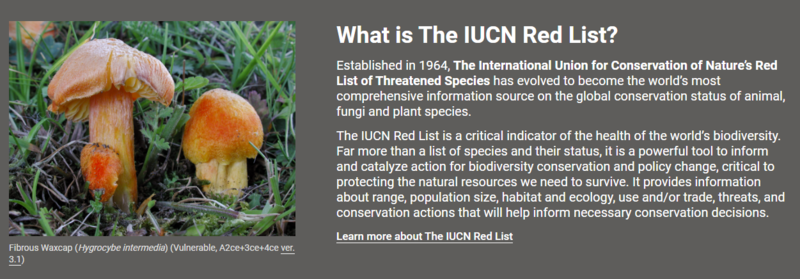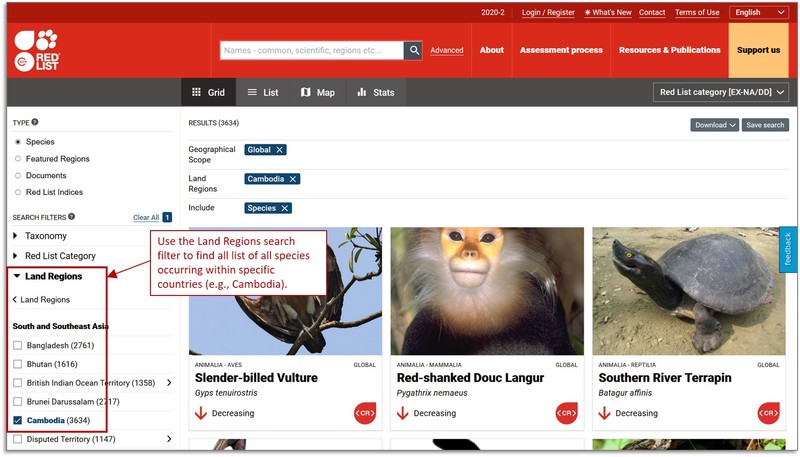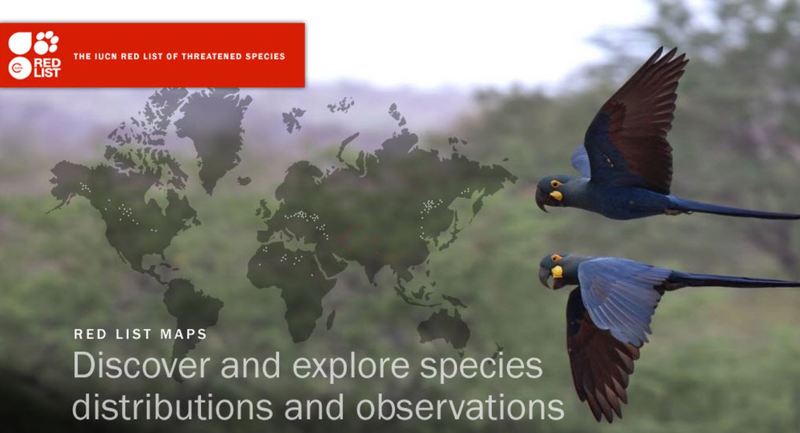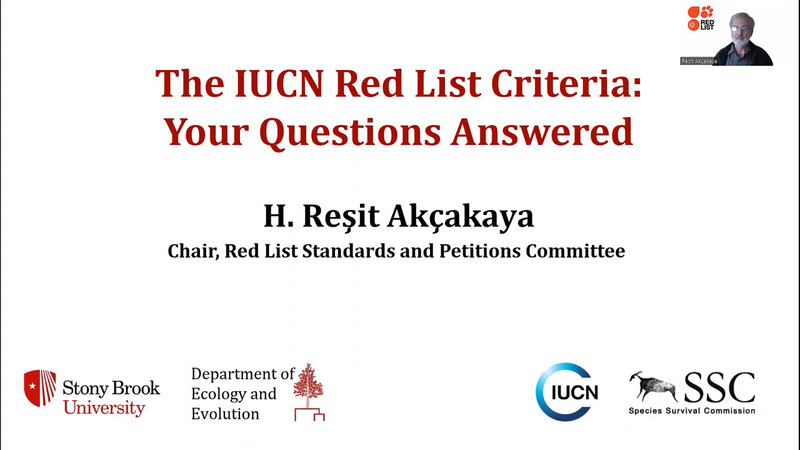What's New Archive
Along with pages being regularly updated to reflect the new data available in each Red List update, new pages, tools and functionality are added to The IUCN Red List website at any time throughout the year.
The "new" IUCN Red List website was launched in November 2018, strengthening the ability of the website to provide data and information on the species included on the Red List.
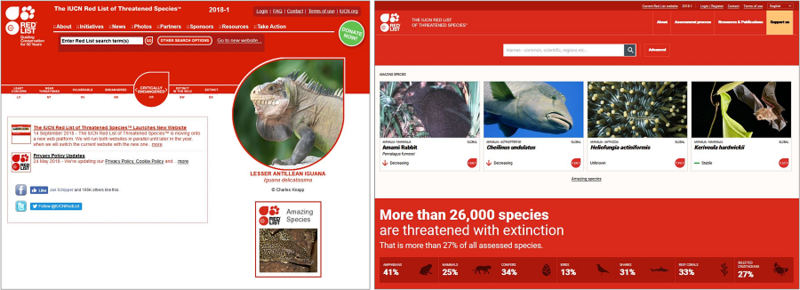
Over the next two years, new pages and tools were added to the website, but with little announcement of these by IUCN. In 2020, the introduction of the "What's New" page changed this and now allows Red List users to quickly see what new developments have happened on the website.
The most recent updates and additions to the website are listed in the current What's New page. All updates and additions since the start of 2020 are listed below.
Interactive Statistics Tables
In 2020, the Red List website introduced automated and interactive tables for some of the summary statistics that previously were only available as PDF documents, starting with the tables for summaries by taxonomic group (tables 3 and 4) and summaries by country (tables 5 and 6). These tables are still available to download as PDF documents, but now they are also available as CSV files. The figures in the tables also include links to the search results page, showing lists of the species these figures refer to. The tables are available in full, or you can decide to view just one section of the table (e.g., fungi only, or species in South America only).
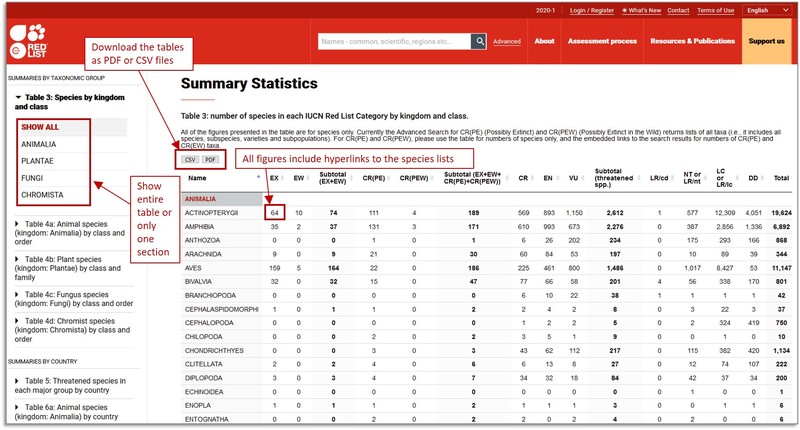
Search filters: Country Legends
In 2020, a Country Legends search filter was added to the Advanced Search. This allows the data to be filtered based on country codes for presence (extant, possibly extant, possibly extinct, extinct post-1500, presence uncertain) and origin (native, reintroduced, introduced, vagrant, origin uncertain, assisted colonisation). The Country Legends filter appears beneath the Land Regions filter in the Advanced Search.

By combining selections in the Land Regions and the Country Legends search filters, search results can be tailored to, for example, find a list of species occurring in a particular country, excluding introduced and vagrant species and species with uncertain occurrence in that country.

Search filters: CR(PE) and CR(PEW)
In 2020, new functionality was introduced to the Advanced Search to allow users to filter the data to show only Critically Endangered taxa that are flagged as Possibly Extinct [CR(PE)] or Possibly Extinct in the Wild [CR(PEW)]. To see these taxa, scroll down the Advanced Search page to the ‘INCLUDE’ section, then use the checkboxes next to ‘CR – Possibly Extinct’ and ‘CR – Possibly Extinct in the Wild’. To see the list of species only, make sure the Species checkbox in the 'INCLUDE' section is ticked; to see the list of subspecies and varieties only, make sure the Subspecies and varieties checkbox is ticked.
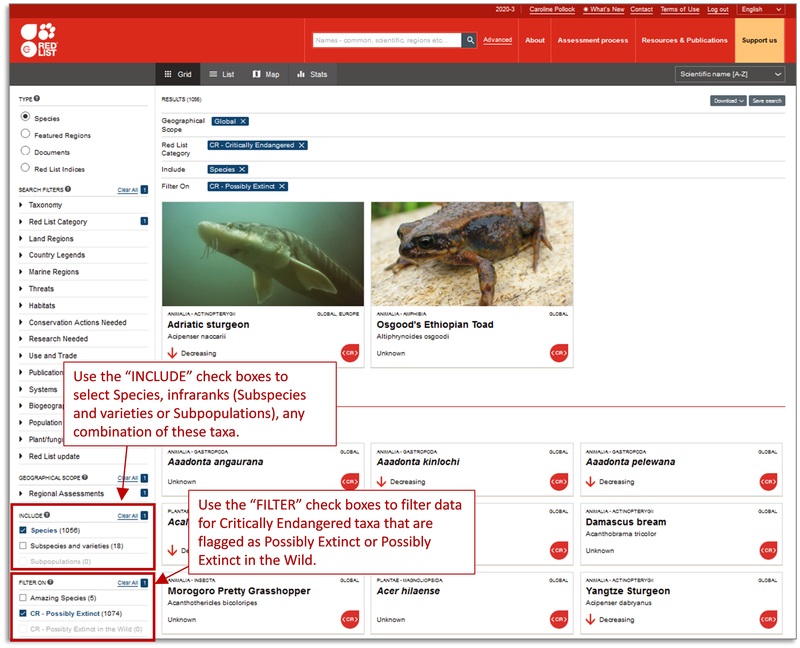
Search filters: Endemics
In 2020, a search filter was added to allow users to find lists of country endemics (i.e., taxa that are recorded as being native to one country only). First, use the Land Regions filter in the Advanced Search page to find the list of taxa occurring in a specific country. The example below shows a search for all species occurring in Cambodia.
Next, scroll down the page to the INCLUDE checkboxes and tick Endemic. In the example, the list of species reduces to 30 endemic species in Cambodia.
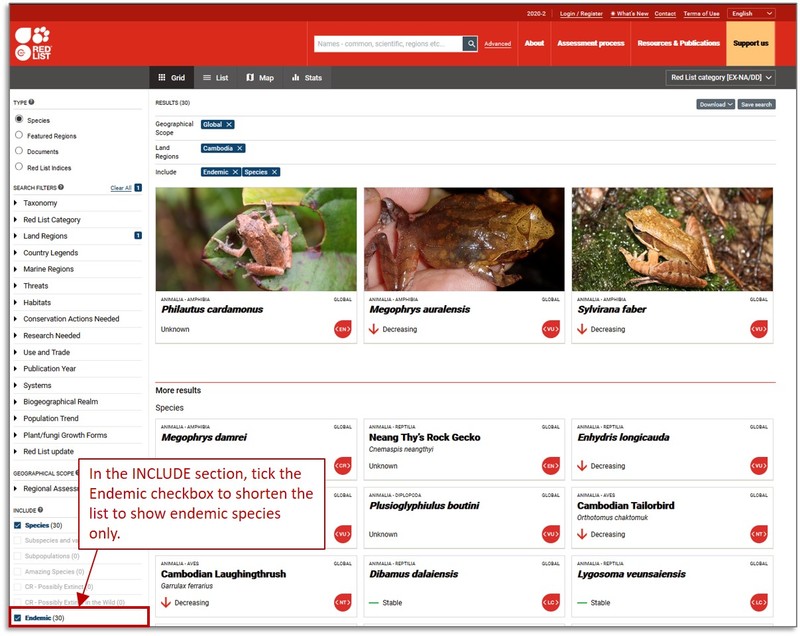
Note: the endemics filter does not work for regional searches. For example, using the endemics filter on the search results for all species occurring in Europe will not result in a list of all species endemic to Europe, as many of the European endemic species will occur in more than one country within Europe.
Search filters: Green Status assessments
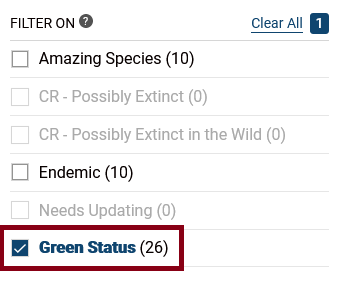 The 2021-3 Red List introduced the first Green Status assessments to the IUCN Red List website. Website users can now filter their search results to find species with Green Status assessments. On the Advanced Search page, scroll down to the "FILTER ON" section to see this filter.
The 2021-3 Red List introduced the first Green Status assessments to the IUCN Red List website. Website users can now filter their search results to find species with Green Status assessments. On the Advanced Search page, scroll down to the "FILTER ON" section to see this filter.
In 2022, eleven new Green Status assessments were added to the Red List website, bringing the total to 37.
Search results: Green Status assessments
In 2022, all species with a Green Status assessment appeared in the search results page, with the Green Status displayed alongside the Red List status. The two-letter abbreviations for Green Status assessments refer to species recovery categories: Indeterminate (ID); Non-Depleted (ND); Fully Recoverd (FR); Slightly Depleted (SD); Moderately Depleted (MD); Largely Depleted (LD); Critically Depleted (CD); Extinct in the Wild (W); and Extinct (EX). For detailed guidelines and Gren Status assessment tools, see here.

Search filters: Needs Updating
IUCN recommends that all Red List assessments be updated at least once every 10 years (ideally every 4-5 years). However, with limited funding and capacity for red listing, this is not always possible. The IUCN Red List therefore includes some assessments that are now more than 10 years old and need to be updated. These are retained on the Red List because they are the most recent extinction risk assessments available for these taxa. In 2020, a filter was added to the Advanced Search to allow users to easily see all assessments that need to be updated.

Search filters: Red List Indices
In 2020, the Red List Indices (RLIs) became available on The IUCN Red List website in the Advanced Search. To search for a Red List Index, select the "Red List Indices" option.
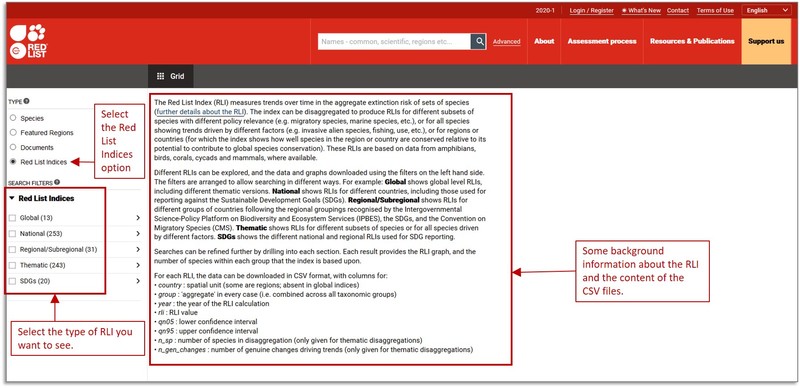
The RLIs are arranged in different subsets: global, regional and subregional, thematic, and Sustainable Development Goals (SDGs). Within each subset, the RLIs are disaggregated to show trends within specific groups (e.g., freshwater species only, species in Brazil, African species, etc.).
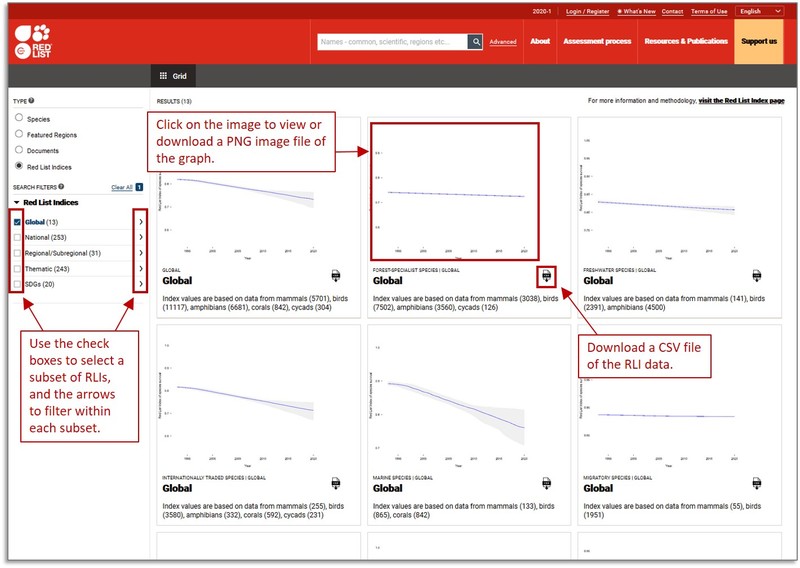
For more information about the Red List Indices, see the Red List Index page.
Assessment page: Abstracts
In the 2021-3 Red List, a short abstract was added to the assessment page, allowing Red List assessments to be more easily found by online academic search engines.

Assessment page: Citation Copy Tool
In 2022, a one-click copy tool was added to the assessment page allowing assessment citations to be copied through just one click of the copy icon to the right of the citation.

Assessment page: Green Status of Species assessments
The 2021-3 update included the first Green Status of Species (GSS) assessments for 26 species, marking a major step forward for the IUCN Red List. Now Red List users can easily see the current risk of extinction (Red List status) and the chances of recovery (Green Status) for species, where these assessments have been carried out.

Note that the Red List assessment and the Green Status assessments have separate citations. These citations appear above the teardrop category image for each assessment. Information icons are also in place to explain the purpose of these different assessments: to see the information panl, place your cursor on the "i" icon next to "THE RED LIST ASSESSMENT" and "THE GREEN STATUS ASSESSMENT" text.
For species with Green Status assessments, information relating to these assessments is displayed throughout the assessment page, highlighted by green text.
Assessment page: Species360
Through a partnership between Species360 and IUCN, from October 2024 species with ex-situ conservation underway have been highlighted on The IUCN Red List via a live link to the Zoological Information Management System (ZIMS). This information is displayed in the External Data section on the online assessment page and the information displayed is updated as the ZIMS database gets updated.
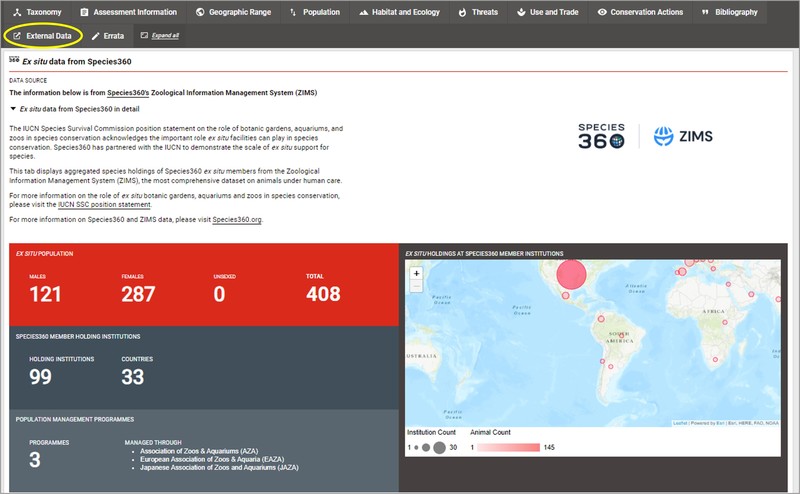
Assessment page: Text Overview
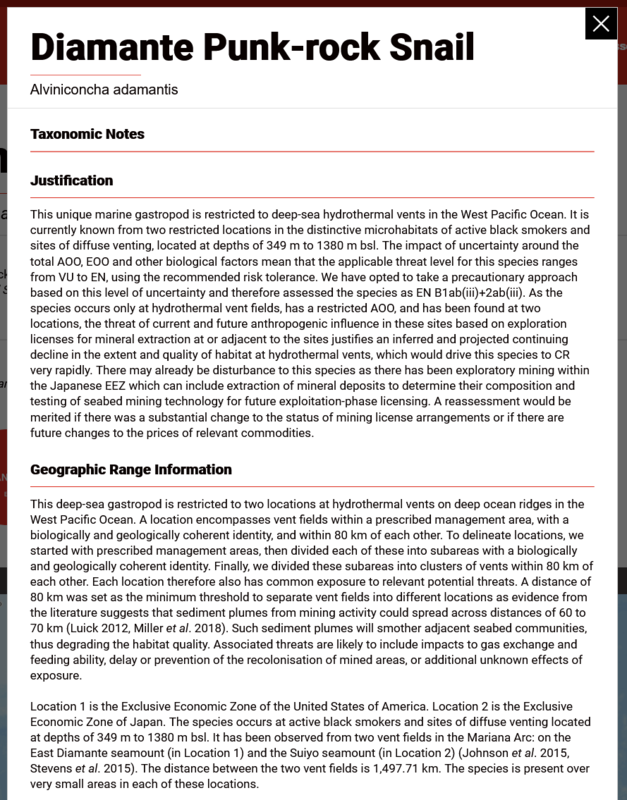 In the 2021-3 Red List update, the text summary was removed from the end of the assessment page. This was replaced by a text overview panel, separate from the main assessment, which users can scroll down through to read all the assessment text. To open this panel, click on the Text Overview button.
In the 2021-3 Red List update, the text summary was removed from the end of the assessment page. This was replaced by a text overview panel, separate from the main assessment, which users can scroll down through to read all the assessment text. To open this panel, click on the Text Overview button.
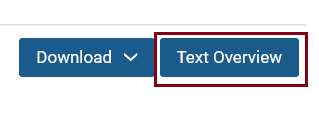
Assessment page: Threat scores
Prior to Red List version 2022-2, IUCN used a scoring scheme to quantify the impact of threats coded for species, based on the timing, scope and severity of these threats. Threat scores were presented in the Threats section in the assessments. However, IUCN now recognises the underdeveloped scientific basis for these impact scores. From version 2022-2, IUCN temporarily removed the threat scores from assessments, while the technical basis for assigning threats and calculating threat impact scores is under review. For more information, see the Threat Classification Scheme page.

Assessment page: Other changes
In addition to introducing the Green Status assessments, abstracts and the text overview panel, the 2021-3 Red List brought in a range of other changes to the assessment page, including:
- A hyperlink to the assessment details at the top of the page, next to the link back to the search results.

- For species with Green Status assessments, the scale bar that shows which category the species is listed under in relation to the other available categories was moved from the top of the assessment page to the Assessment Details section to accommodate the additional Green Status information in the assessment. A new scale bar was also introduced to display the Green Status categories.
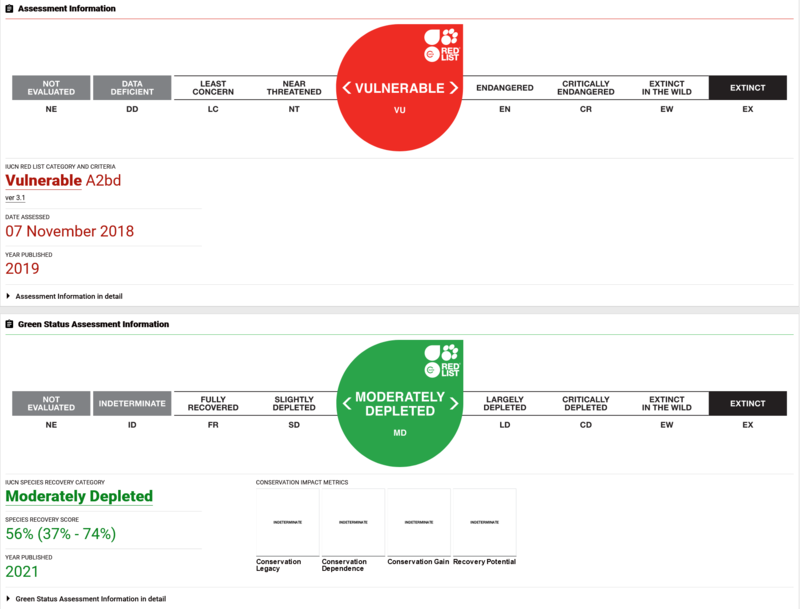
Assessments for species that do not have a Green Status assessment still display the Red LIst scale bar at th top of the assessment page.
- The assessment summary information was reduced by removing the summary of habitats, threats and conservation actions codes. These codes are provided in the detailed assessment. Removing these from the summary informaiton section shortened the length of the assessment paages, making them easier to read through.

Indigenous & Local Knowledge (ILK) Guidelines
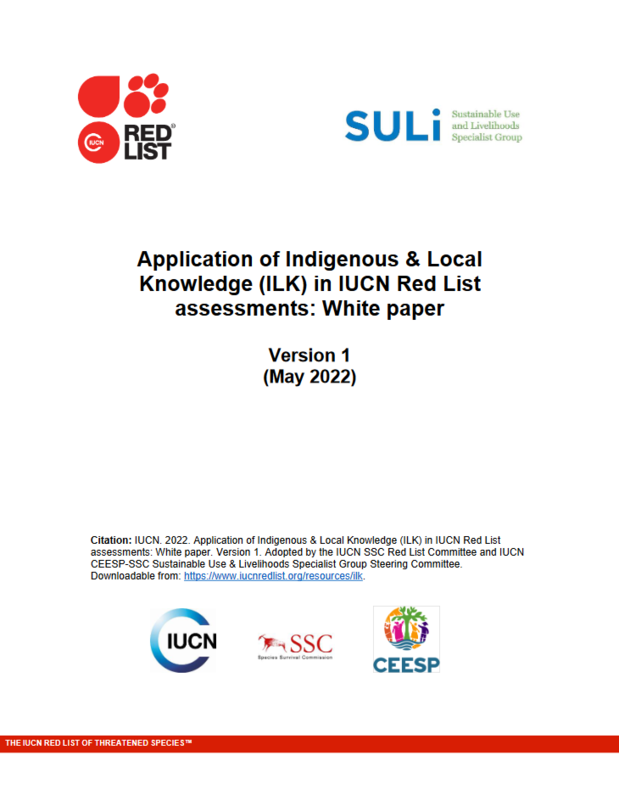 Building on discussions over at least the last decade between the IUCN CEESP-SSC Sustainable Use and Livelihoods Specialist Group and the IUCN SSC Red List Committee, with insights gained from the IPBES Indigenous & Local Knowledge (ILK) Approach, IUCN released the guidance document Application of Indigenous & Local Knowledge (ILK) in IUCN Red List assessments. This document aims to examine all the issues and general principles surrounding the application of indigenous and local knowledge (ILK) in the IUCN Red List of Threatened Species and to outline some key steps to enhance this application in Red List assessments. This document was added to the Red List website in 2022, and is available to download (in English, French and Spanish) from here.
Building on discussions over at least the last decade between the IUCN CEESP-SSC Sustainable Use and Livelihoods Specialist Group and the IUCN SSC Red List Committee, with insights gained from the IPBES Indigenous & Local Knowledge (ILK) Approach, IUCN released the guidance document Application of Indigenous & Local Knowledge (ILK) in IUCN Red List assessments. This document aims to examine all the issues and general principles surrounding the application of indigenous and local knowledge (ILK) in the IUCN Red List of Threatened Species and to outline some key steps to enhance this application in Red List assessments. This document was added to the Red List website in 2022, and is available to download (in English, French and Spanish) from here.
IUCN Green Status of Species page
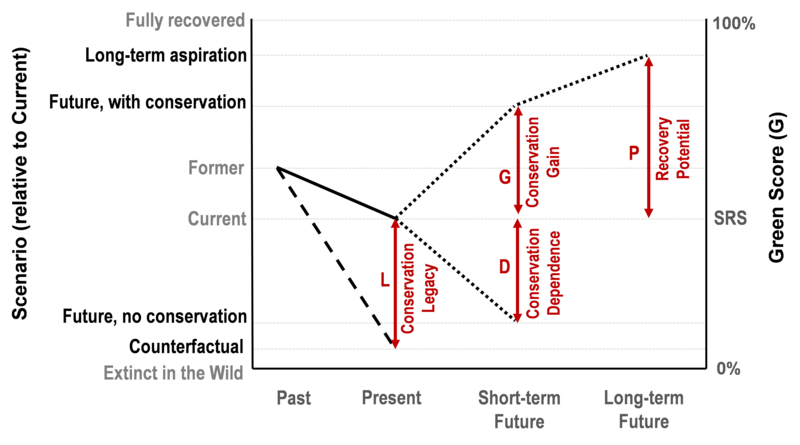 The Green Status of Species assesses the recovery of species’ populations and measures conservation success. In 2020, new pages were added to the website providing more information about the Green Status of Species: IUCN Green Status of Species and Measuring Recovery with the IUCN Green Status of Species. The Green Status of Species Guidelines and Assessment Materials page was also added to the Resources section, allowing users to download guidelines and tools.
The Green Status of Species assesses the recovery of species’ populations and measures conservation success. In 2020, new pages were added to the website providing more information about the Green Status of Species: IUCN Green Status of Species and Measuring Recovery with the IUCN Green Status of Species. The Green Status of Species Guidelines and Assessment Materials page was also added to the Resources section, allowing users to download guidelines and tools.
In August 2024, the Background and Guidelines for the IUCN Green Status of Species was updated to version 2.0 (in English only; currently the most recent version for French and Spanish is still version 1.0). The updated guidelines are available here.
Green Status Supplementary Information page
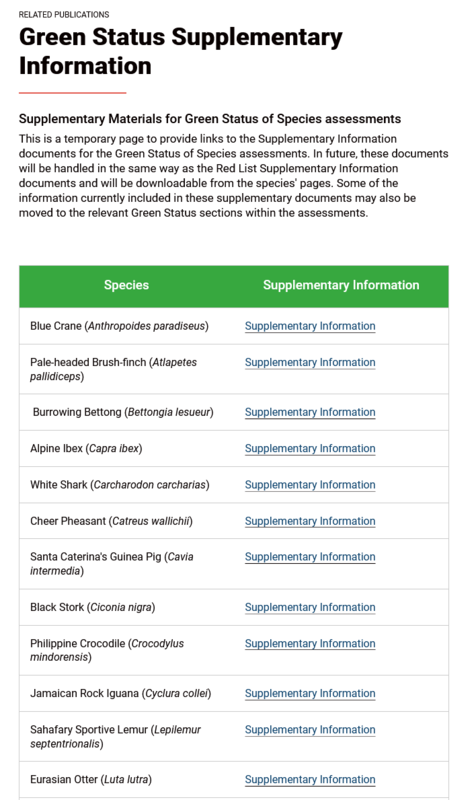
Green Status of Species (GSS) assessments have supplementary information documents attached to them. In the 2021-3 Red List, development was still underway to make this information available via the "Download" button in the assessment. Until the Download button could include these documents, they are available on a temporary page: Green Status Supplementary Information.
Currently, the GSS supplementary information documents include graphs showing the Green Scores for the assessed species; the list of past, current and planned future conservation actions; and the list of past, current and expected future threats across the species' range.
The assessment page includes a link to the temporary supplementary information page; to go directly to the Green Status Supplementary Information page, click here.
Online Green Status training course
The online IUCN Red List Assessor training course for has been available since 2013. In 2022, a new online course for the IUCN Green Status of Species was released, developed in partnership with Re:wild, University of Oxford and the Zoological Society of London. The Green Status of Species training course is available on the TNC's ConservationTraining website, alongside the Red List Assessor training course. A link to the new course is now included in the Online Red List and Green Status Training page.
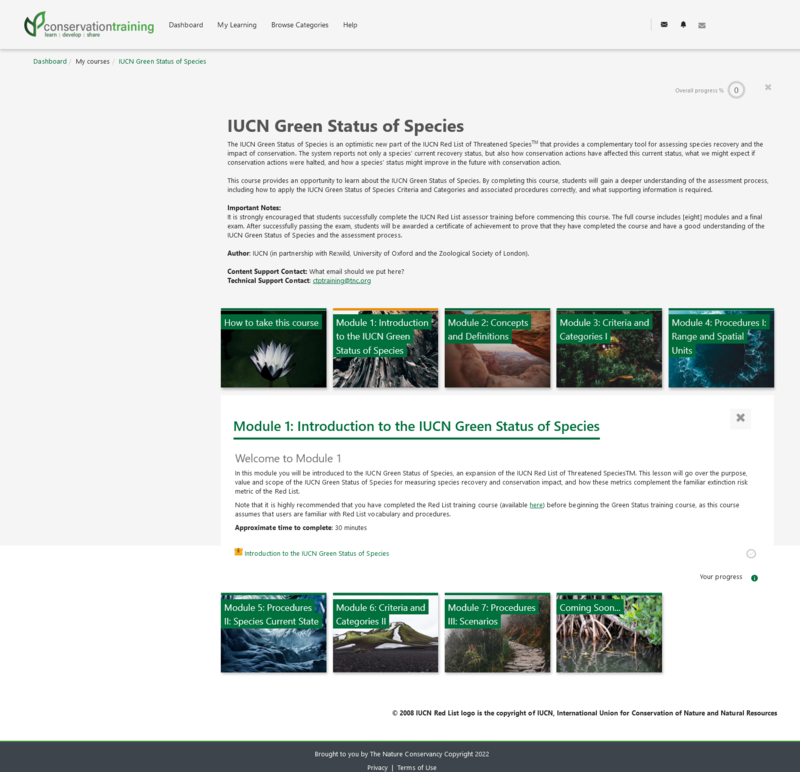
Frequently Asked Questions page
 The IUCN Red List Unit receives thousands of emails each year, often from people asking about how Red List data can be used, the assessment process, how to use the website, and how people can help species. The Frequently Asked Questions (FAQ) page was added to the website in 2020 to provide answers to many of these questions.
The IUCN Red List Unit receives thousands of emails each year, often from people asking about how Red List data can be used, the assessment process, how to use the website, and how people can help species. The Frequently Asked Questions (FAQ) page was added to the website in 2020 to provide answers to many of these questions.
Supporting Information page
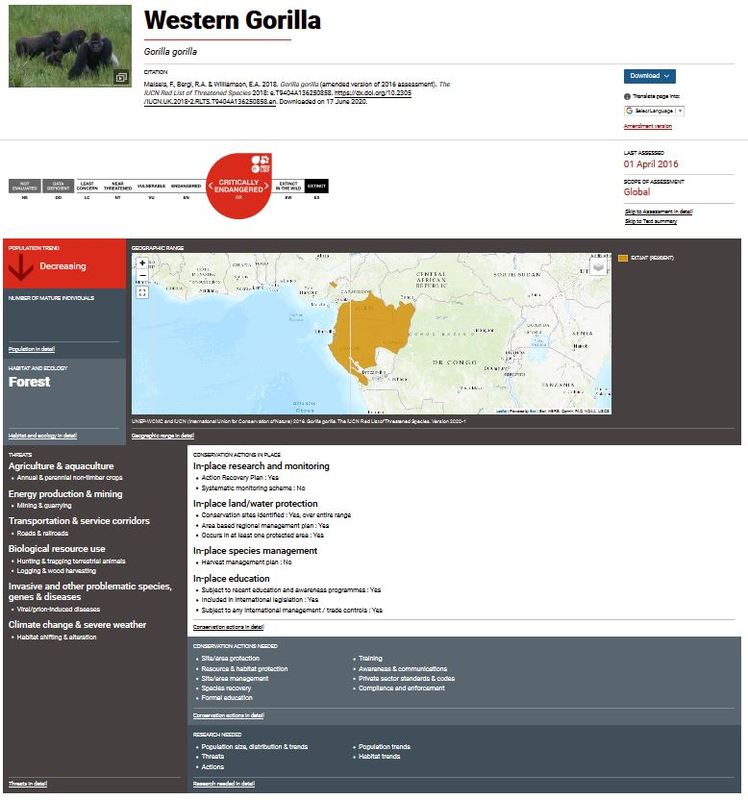
Red List Index page
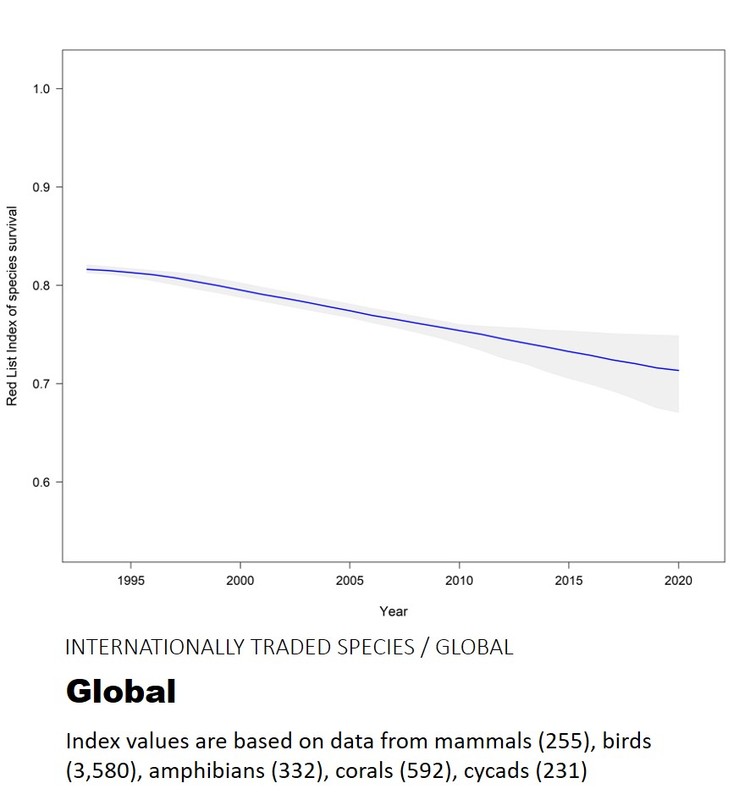 In addition to the Red List Indices being added to the website, the Red List Index (RLI) page was also updated in 2020 to provide more information about what the RLI tells us about the state of biodiversity, how RLIs are used, links to more RLI publications, and guidance on calculating RLIs.
In addition to the Red List Indices being added to the website, the Red List Index (RLI) page was also updated in 2020 to provide more information about what the RLI tells us about the state of biodiversity, how RLIs are used, links to more RLI publications, and guidance on calculating RLIs.
SIS News and Updates
 The Species Information Service (SIS) is the data management system used by the IUCN Red List to allow assessors from around the world to access, edit and submit assessments for publication on the Red List website. The SIS News and Updates page is updated regularly as new data fields are added and new tools and functionality are brought into SIS.
The Species Information Service (SIS) is the data management system used by the IUCN Red List to allow assessors from around the world to access, edit and submit assessments for publication on the Red List website. The SIS News and Updates page is updated regularly as new data fields are added and new tools and functionality are brought into SIS.
SIS Self-teach Tools & Guidance Documents
 The Species Information Service (SIS) is the data management system used by IUCN to store and manage species accounts and assessments for publication on the IUCN Red List. Some SIS users have access to data management tools to help them manage assessment projects.
The Species Information Service (SIS) is the data management system used by IUCN to store and manage species accounts and assessments for publication on the IUCN Red List. Some SIS users have access to data management tools to help them manage assessment projects.
A set of guidance documents was created to help these users make the most of the tools and functions in SIS. These documents are now available to download from the SIS Self-teach Tools and Guidance Documents page.
Summary Statistics page
In 2020, links were added to the Summary Statistics page to direct users to the automated statistics page for summaries by taxonomic group (tables 3 and 4) and summaries by country (tables 5 and 6). Note that from the 2022-1 Red List onwards, the calculation for proportion of threatened species now includes threatened (CR, EN and VU) AND Extinct in the Wild (EW) species.
Spatial Data Download page
Prior to 2020, the Spatial Data Download page only allowed polygon spatial data downloads. In 2020, bulk downloads of point data were added to this page, where these data are available (mostly for plant groups, but also for some invertebrate groups).
Red List Guidelines
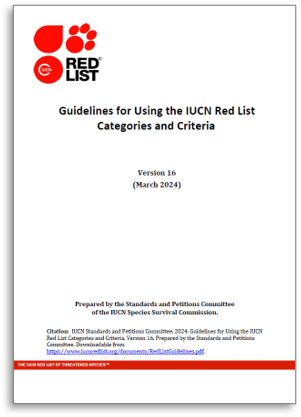 In March 2024, the Guidelines for Using the IUCN Red List Categories and Criteria were updated to version 16. To downloadthe current version of the Red List Guidelines (in English), click here.
In March 2024, the Guidelines for Using the IUCN Red List Categories and Criteria were updated to version 16. To downloadthe current version of the Red List Guidelines (in English), click here.
Note that currently (June 2024), the most recent French and Spanish translations are for version 14, and the most recent Portuguese translation is for version 15.1.
Regional Assessments: Distribution Maps
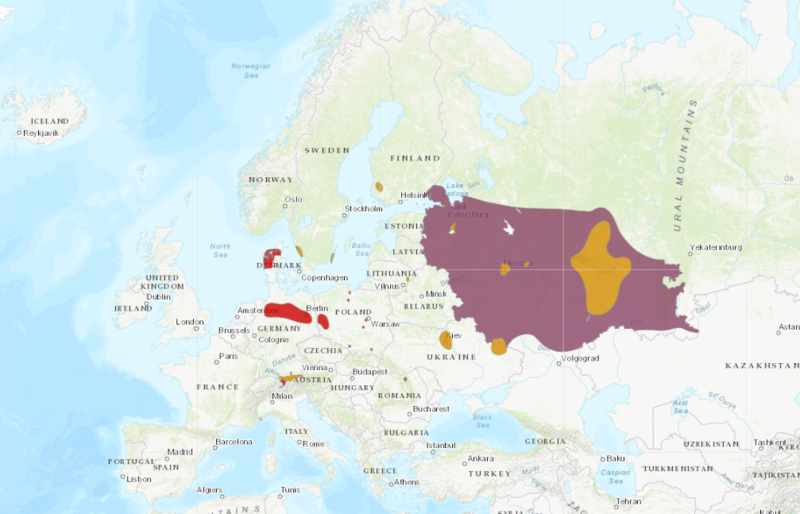 As from 2024-1, Regional assessments published on The IUCN Red List include distribution maps and the option of downloading these spatial data. Note that distribution maps for regional assessments may differ from the global assessment map for the same species (see Supporting Information page for more information on this).
As from 2024-1, Regional assessments published on The IUCN Red List include distribution maps and the option of downloading these spatial data. Note that distribution maps for regional assessments may differ from the global assessment map for the same species (see Supporting Information page for more information on this).
Guidelines for Appropriate Uses of Red List Data
In July 20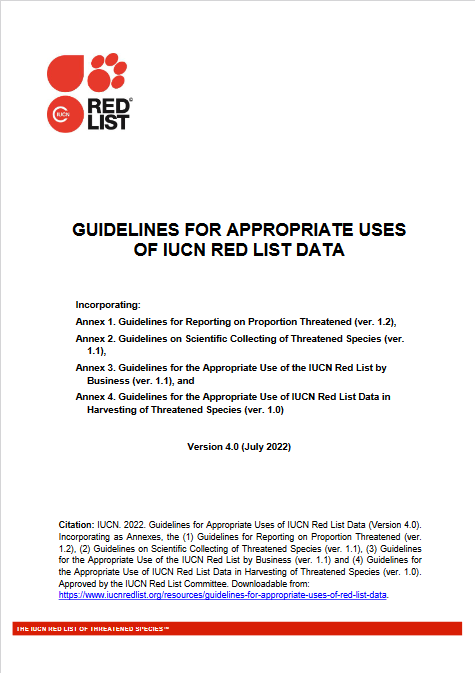 22, the Guidelines for Appropriate Uses of Red List Data were updated to version 4.0. Changes to this document include:
22, the Guidelines for Appropriate Uses of Red List Data were updated to version 4.0. Changes to this document include:
- Annex 1: for reporting purposes, the revised formulas for proportion of threatened species now include Extinct in the Wild (EW) species with Critically Endangered (CR), Endangered (EN) and Vulnerable (VU) species.
- Annexes 2 and 3: hyperlinks to additional resources have been updated.
- Annex 4: this new Annex provides Guidelines for the Appropriate Use of IUCN Red List data in Harvesting of Threatened Species.
The updated guidelines and the annexes are available here.
Guidelines for Establishing a National Red List Programme
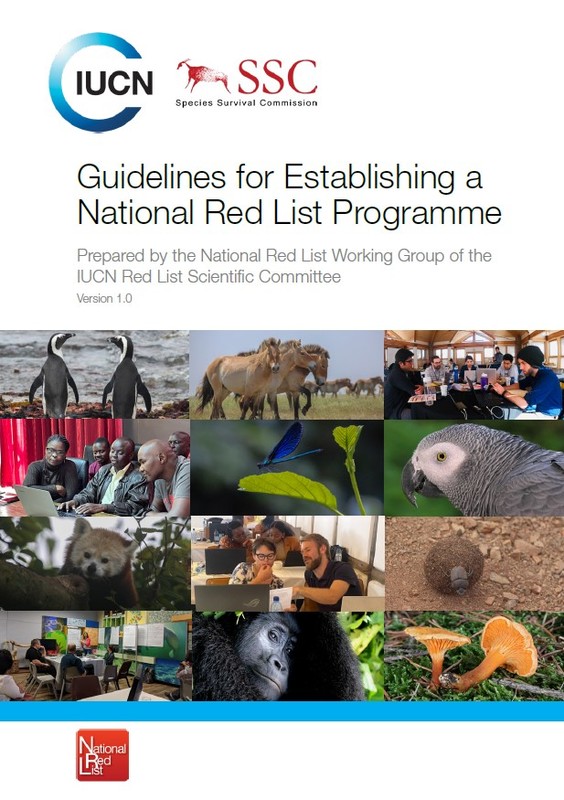 Building on many years' experience in all aspects of red listing, in October 2024 the National Red List Working Group of the IUCN Red List Scientific Committee published step-by-step guidance to help countries develop their own national Red List programmes. These guidelines are available here (in English, French and Spanish).
Building on many years' experience in all aspects of red listing, in October 2024 the National Red List Working Group of the IUCN Red List Scientific Committee published step-by-step guidance to help countries develop their own national Red List programmes. These guidelines are available here (in English, French and Spanish).
Extinction Risk Assessment tools
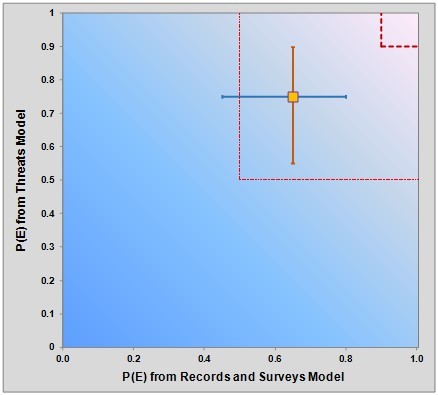 The most recent update of the Guidelines for Using the IUCN Red List Categories and Criteria (version 14) included reference to two models (a Threats model and a Records and Surveys model) that help Assessors determine the probability of a species now being Extinct or Extinct in the Wild. In 2020, the Extinction Risk Assessment tools page was added to give users access to both of these extinction probability models. In 2021, these tools were also made available in French and Spanish.
The most recent update of the Guidelines for Using the IUCN Red List Categories and Criteria (version 14) included reference to two models (a Threats model and a Records and Surveys model) that help Assessors determine the probability of a species now being Extinct or Extinct in the Wild. In 2020, the Extinction Risk Assessment tools page was added to give users access to both of these extinction probability models. In 2021, these tools were also made available in French and Spanish.
Range Map Image files
All assessment Fact Sheets on the Red List website include a Download tool, where a range of files are available (e.g., the PDF version of the assessment, any supplementary information, spatial data, etc.). In 2020, it was made possible for users to use thus tool to download a JPG image file of the range map.
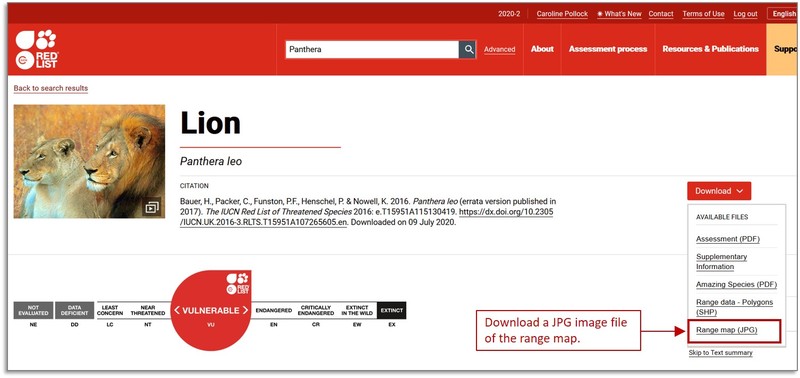
Click on the link to open the image file. To save the image file, right-click on the image and select "Save Image As...".
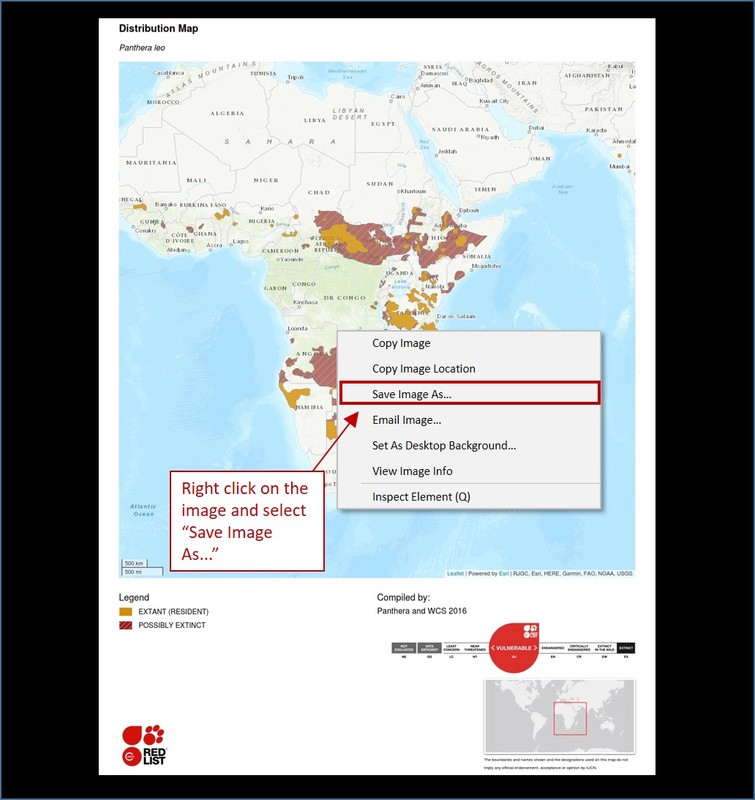
IUCN Red List Webinars
In 2022, the IUCN Red List, in collaboration with ABQ Biopark, initiated a series of webinars about the IUCN Red List. The new IUCN Red List webinars page makes these recorded webinars freely available to everyone. This page includes all Red List webinars released by the IUCN Red List Unit and links to relevant webinars on external websites about global, regional and national Red Lists and Red List tools.
Pages available in Spanish
The IUCN Red List website has the option to change the language setting from English to French, Spanish or Japanese (see the top right corner of the website). We do not yet have complete translations for all pages on the website, but we are gradually adding translated versions as they become available. In particular, the number of pages translated into Spanish on the IUCN Red List website continues to grow each year.
IUCN Red List 2017-2020 Report
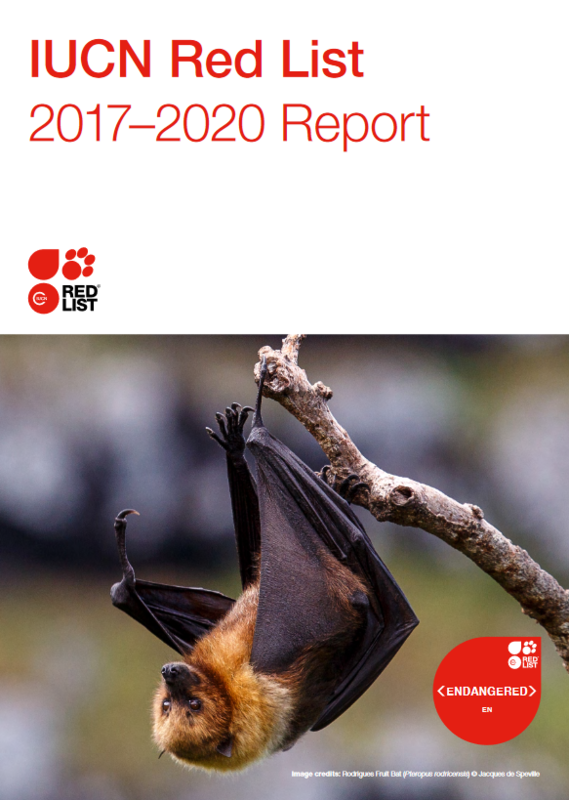 In 2021, the 2017-2020 IUCN Red List quadrennial report was made available on the Red List website. This report captures the highlights of the conservation impact of The IUCN Red List of Threatened Species over the 2017–2020 quadrennial. It represents the collective efforts of the IUCN Red List Partnership and reports against the ten target Results of the IUCN Red List Strategic Plan (2017-2020). To download this report, go to the Resources and Publications section on the website.
In 2021, the 2017-2020 IUCN Red List quadrennial report was made available on the Red List website. This report captures the highlights of the conservation impact of The IUCN Red List of Threatened Species over the 2017–2020 quadrennial. It represents the collective efforts of the IUCN Red List Partnership and reports against the ten target Results of the IUCN Red List Strategic Plan (2017-2020). To download this report, go to the Resources and Publications section on the website.
Scientific papers
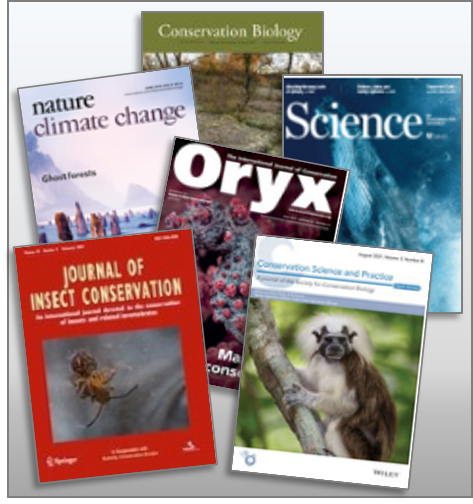 The IUCN Red List of Threatened Species often inspires scientific research and comments. As new papers are published, the Red List website adds links to those papers and journals to help Red List users to find the most current and relevant analyses and information available. Explore the recently published papers in the Scientific Papers section in Resources and Publications.
The IUCN Red List of Threatened Species often inspires scientific research and comments. As new papers are published, the Red List website adds links to those papers and journals to help Red List users to find the most current and relevant analyses and information available. Explore the recently published papers in the Scientific Papers section in Resources and Publications.
Data Repository
 Spatial and tabular data from The IUCN Red List are used in many analyses and the results published in scientific papers. Since the IUCN Red List is regularly updated, it is not practical for people to rely on exporting current assessment data to replicate these analyses. Therefore, in 2023, a Data Repository page was added to the Red List website to hold the Red List datasets used in analyses and publications that are primarily lead by people associated with IUCN, making these permanently available.
Spatial and tabular data from The IUCN Red List are used in many analyses and the results published in scientific papers. Since the IUCN Red List is regularly updated, it is not practical for people to rely on exporting current assessment data to replicate these analyses. Therefore, in 2023, a Data Repository page was added to the Red List website to hold the Red List datasets used in analyses and publications that are primarily lead by people associated with IUCN, making these permanently available.
sRedList
 In October 2023, the sRedList platform was launched. This Red List tool is a user-friendly web-interface, which allows users to download and filter occurrence records, to create distribution maps, to calculate area of occupancy (AOO), to map trends in area of habitat or forest cover, to extract lists of countries of occurrence and habitat preferences, or to assess severe fragmentation. The new sRedList page on the IUCN Red List website includes a link to the sRedList website and tool.
In October 2023, the sRedList platform was launched. This Red List tool is a user-friendly web-interface, which allows users to download and filter occurrence records, to create distribution maps, to calculate area of occupancy (AOO), to map trends in area of habitat or forest cover, to extract lists of countries of occurrence and habitat preferences, or to assess severe fragmentation. The new sRedList page on the IUCN Red List website includes a link to the sRedList website and tool.
Species Richness and Rarity-weighted Richness Data
A new Species Richness and rarity-weighted Richness Data page was added to the Red List website in 2023, allowing users to download spatial data files (and map images) for species richness and rarity maps based on the IUCN ranges for amphibians, birds, mammals and reptiles.
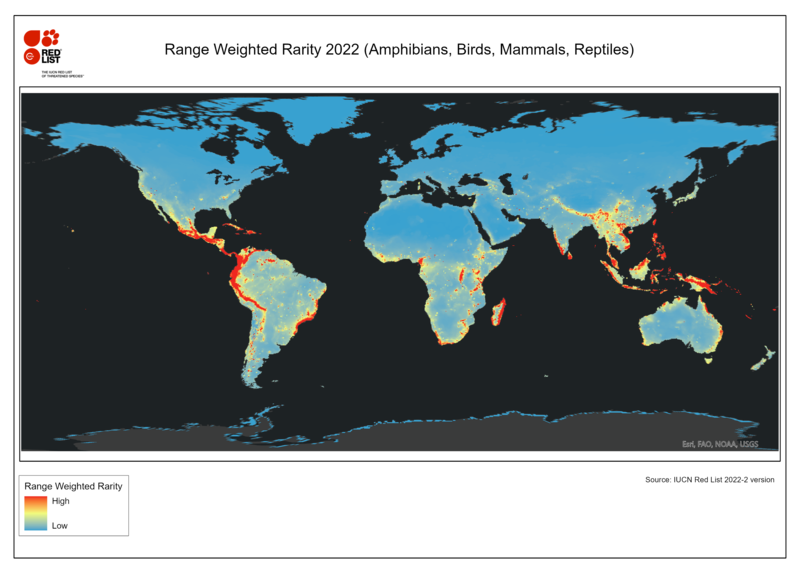
State of the World's Amphibians: The Second Global Amphibian Assessment
 The second global amphibian assessment was released in October 2023, and can be downloaded from here. This report provides an update on the status of the world's amphibians, the pressures upon them, and the solutions needed for massively scaling up their conservation. Through the second Global Amphibian Assessment, more than a decade of data from research on amphibians by over 1,000 experts was compiled to assess the extinction risk of 8,011 species.
The second global amphibian assessment was released in October 2023, and can be downloaded from here. This report provides an update on the status of the world's amphibians, the pressures upon them, and the solutions needed for massively scaling up their conservation. Through the second Global Amphibian Assessment, more than a decade of data from research on amphibians by over 1,000 experts was compiled to assess the extinction risk of 8,011 species.
Supplementary Information Templates
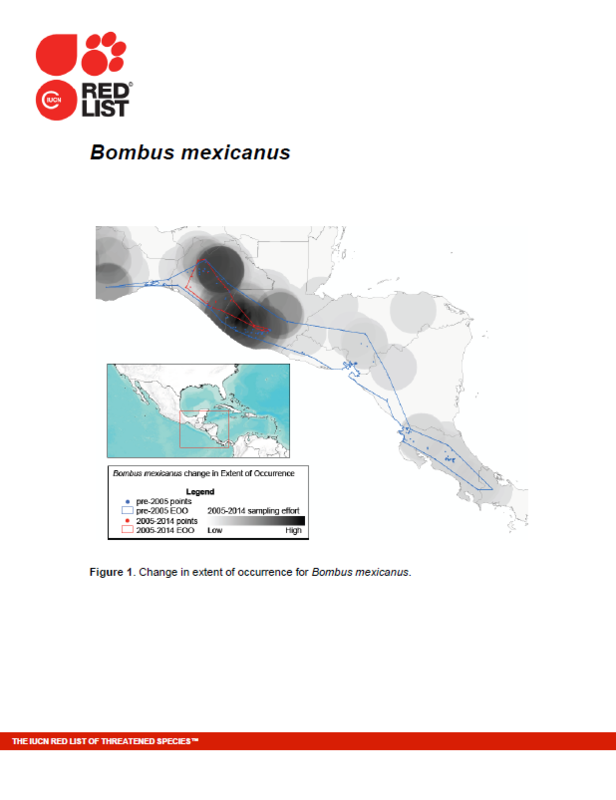 Assessors working on Red List assessments sometimes need to attach supplementary information documents containing additional information and data that cannot be included within the main assessment. A set of standard templates is now available on the Supporting Information Guidelines page.
Assessors working on Red List assessments sometimes need to attach supplementary information documents containing additional information and data that cannot be included within the main assessment. A set of standard templates is now available on the Supporting Information Guidelines page.
Petition Results
 All IUCN Red List assessments are open to challenge, and a petitions process is in place to handle cases where there is disagreement on an assessment that cannot be resolved through informal discussions. Go to the Petitions Page to see the results of all petitions.
All IUCN Red List assessments are open to challenge, and a petitions process is in place to handle cases where there is disagreement on an assessment that cannot be resolved through informal discussions. Go to the Petitions Page to see the results of all petitions.
Procedure for Handling of Petitions against Current Listings on The IUCN Red List of Threatened Species™
 The Procedure for Handling of Petitions again Current Listings on The IUCN Red List of Threatened Species™ has been updated to version 4 (June 2024). Click here to download the current version of these guidelines.
The Procedure for Handling of Petitions again Current Listings on The IUCN Red List of Threatened Species™ has been updated to version 4 (June 2024). Click here to download the current version of these guidelines.
API v3 replaced by API v4
The v3 API was removed shortly after the 2025-1 Red List update on the 27th March 2025. The last update to the underlying data for the v3 API was Red List version 2024-2. All users were asked use the v4 API which can be accessed here.
Please note: no v3 API accounts were migrated over to the v4 API so users must sign up for a new account to begin using this service.

European Red List: Dragonflies
 The publication Measuring the Pulse of European Biodiversity. European Red List of Dragonflies & Damselflies is a report of the updated status of Odonata species across Europe. In December 2024, the data for this report were made available in the Red List Data Repository.
The publication Measuring the Pulse of European Biodiversity. European Red List of Dragonflies & Damselflies is a report of the updated status of Odonata species across Europe. In December 2024, the data for this report were made available in the Red List Data Repository.
Search filters: European Union
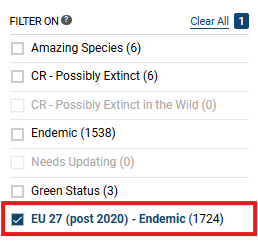 In March 2025, the IUCN Red List version 2025-1 introduced a new search filter on the Advanced Search page, allowing users to filter search results to show all taxa endemic to the European Union (EU) region. In March 2025, this included 27 EU countries: Austria, Belgium, Bulgaria, Croatia, Republic of Cyprus, Czech Republic, Denmark, Estonia, Finland, France, Germany, Greece, Hungary, Ireland, Italy, Latvia, Lithuania, Luxembourg, Malta, Netherlands, Poland, Portugal, Romania, Slovakia, Slovenia, Spain and Sweden.
In March 2025, the IUCN Red List version 2025-1 introduced a new search filter on the Advanced Search page, allowing users to filter search results to show all taxa endemic to the European Union (EU) region. In March 2025, this included 27 EU countries: Austria, Belgium, Bulgaria, Croatia, Republic of Cyprus, Czech Republic, Denmark, Estonia, Finland, France, Germany, Greece, Hungary, Ireland, Italy, Latvia, Lithuania, Luxembourg, Malta, Netherlands, Poland, Portugal, Romania, Slovakia, Slovenia, Spain and Sweden.
Regional assessment pages: regional categories
In March 2025, the Red List categories bar on the regional assessment pages was updated to show all regional Red List categories, including Regionally Extinct and Not Applicable.
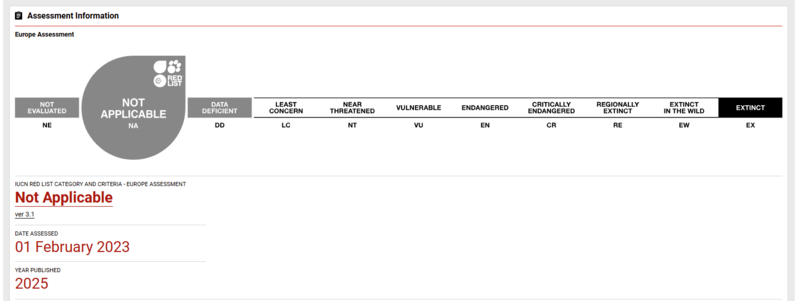
Regional assessment pages: distribution maps
From March 2025, all regional assessments with distribution maps have included the map on the assessment page.
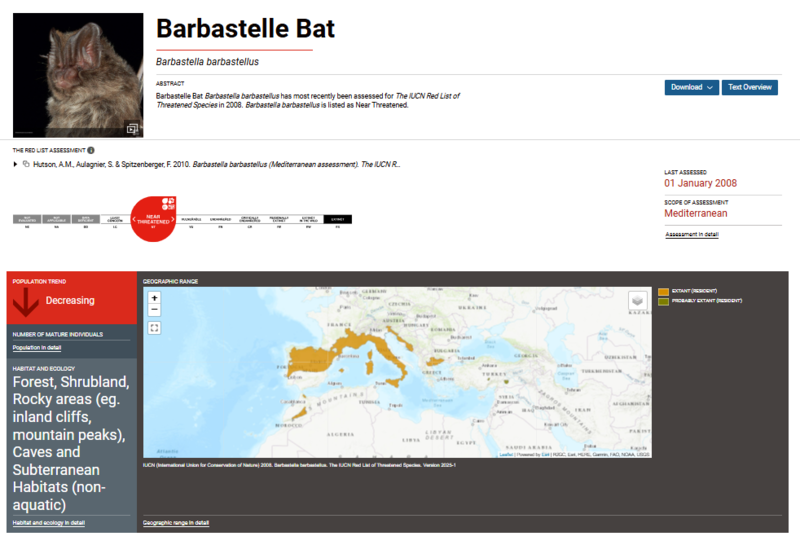
Mapping Biodiversity Priorities
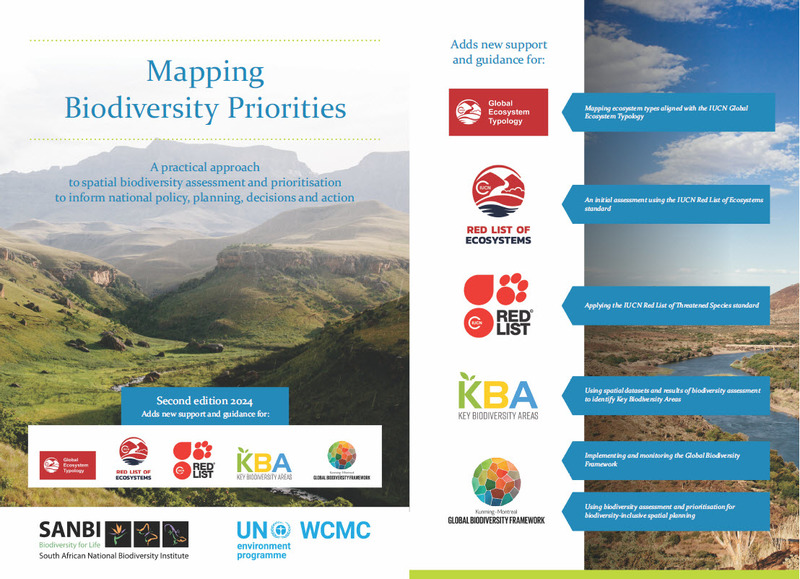 Spatial data and mapping can provide multiple benefits for biodiversity strategies and action planning at a national scale. However, few countries include any spatial data strategies in their National Biodiversity Strategies and Action Plans (NBSAPs). This publication (available here) shows how it is possible to use available spatial data to conduct a useful national assessment of biodiversity in a short space of time and with minimal resources.
Spatial data and mapping can provide multiple benefits for biodiversity strategies and action planning at a national scale. However, few countries include any spatial data strategies in their National Biodiversity Strategies and Action Plans (NBSAPs). This publication (available here) shows how it is possible to use available spatial data to conduct a useful national assessment of biodiversity in a short space of time and with minimal resources.
IUCN Red List updates
The IUCN Red List is updated regularly to refresh existing assessments and bring in species assessed for the first time. The media release for the current and for all past versions of the IUCN Red List is available on the IUCN Red List Media Releases page and the schedule for future updates is shown on the Planned Red List Updates page.
